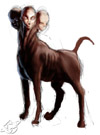
 |
|
Everyone agrees that Hell is an unpleasant place; if Milton can be believed, Satan himself can barely stand the place. This makes it a very popular setting for computer games; after all, it's an actively antagonistic environment that can be stocked with a variety of frightening denziens. But despite the wealth of creativity Hell offers, all too often it degenerates into lava pools and shotguns. Irrational Games, the creators of System Shock 2, wants to take gamers to Hell with their PS2 adventure game, The Lost. This time, however, the horrors of the afterlife are more than fireballs and rotting zombies -- The Lost is set in the carefully crafted Hell of the Italian poet Dante Alighieri, and the title promises to emphasize psychological horror and despair over double-barreled demon blasting.
The protagonist, medical student Amanda Wright, is a struggling single mother of a daughter, Beatrice. Beatrice dies, unbaptised, in a terrible car accident. The metaphysics of The Lost's universe being what they are, Amanda's daughter ends up in Hell despite her youth and innocence. Amanda, understandably, falls into despair, going so far as to consider suicide. In the midst of this sorrow, the Devil himself appears to her and offers her a chance to rescue her daughter. The stakes, of course, are Amanda's immortal soul. Amanda accepts and finds herself in the outer ring of Limbo. The Hell of Dante's "Inferno" is a regimented series of nine concentric rings, each more terrible than the last. The sinners in each ring are subjected to a different punishment, each according to the sin, and the deeper one descends into Hell, the more horrible the terrors one experiences. This structure lends itself well to a videogame, both for pacing and for constantly changing environments. Irrational Games has taken some liberties in updating the setting to the modern day; industrial cattle-cars now ferry the souls of the dead pass Minos, the gatekeeper; the circle of Corruption is a spiral of rotting platforms with a foul, spewing beast at the bottom of a central pit. The Circle of the Violent now resembles a bombed-out Dresden; trenches are lined with barbed wire and the flashing light of shrapnel fills the sky. Bizarrely, yet fittingly, the circle of Avarice looks for all the world like Las Vegas. Though the intervening centuries has changed Hell, it's still a bleak, desolate wasteland and the final destination of the damned. Harsh punishment, whether deserved or not, is still the modus operandi.
Fortunately, guidance for Amanda comes from both without and within. After she rescues him from imprisonment, the poet Virgil will serve as her guide. The years intervening years since he guided Dante through the Inferno have taken their toll on the Roman poet, and his appearance is now scarred and reptilian. Amanda can also "shift" into four different personas, each representing a different part of her nature. These four characters are Instinct, Light, Shadow, and Corruption.
Instinct is Amanda's violent and protective nature. She is the primary warrior and has the most strength and vitality. Light, a healer, can cast curative and protective spells. Shadow is a thief-like character with an emphasis on stealth and cunning. He can backstab enemies, manuever around tight spots in the environment, as well as cloak himself in shadow and hide from enemies. Corruption can cast apocalyptic spells of death and destruction. Finally, take enough damage in any of the forms and Amanda reverts to her base form: Amanda. Though she defend herself marginally in this state, you'll most likely want to revert to one of the four other personas as quickly as possible.
All characters share a pool of Mana from which spells and shapeshifting are drawn. Vitality, however, varies by character; Instinct currently has the most, while Light is the most frail. When Amanda levels up, she can assign points to the various personas to increase their skill. Much like System Shock 2's cybermodule, distributing points lets each player develop his or her own style for playing through the game. The game is still early in development, so most characters have yet to receive their full set of abilities. Interestingly, Amanda can free some of the souls she meets, gaining a bit of their energy and learning their tale of woe. Players will be able to access over 70 weapons, shields, and spells unique to the various characters, as well as dozens of special items that can be used by any persona.
Currently, only the early stages of the game are playable, but what's present is expansive and impressive. The game uses version 3.0 of Monolith's LithTech engine, allowing for moody lighting and wide, outdoor environments. The game mixes action and adventure from a third-person perspective, and the levels are being designed to take advantage of all the different personas. Irrational Games has created a proprietary tool called "Backlot" to simplify the addition of environments, camera movements, obstacles, and scripted events. Though Irrational Games has a PC background, they are developing The Lost from the ground up as a console game, and are well aware of the different expectations and realities console players have. If they can meld the mature sensibilities, tense atmosphere, and state-of-the-art aesthetics of their previous titles with the gameplay console gamers crave, Hell may become one of the PS2's most desired travel destinations. Preview by Andrew Vestal, GIA. |
|
||||||||||||||||||||||||||||||||||||||||||||||||




